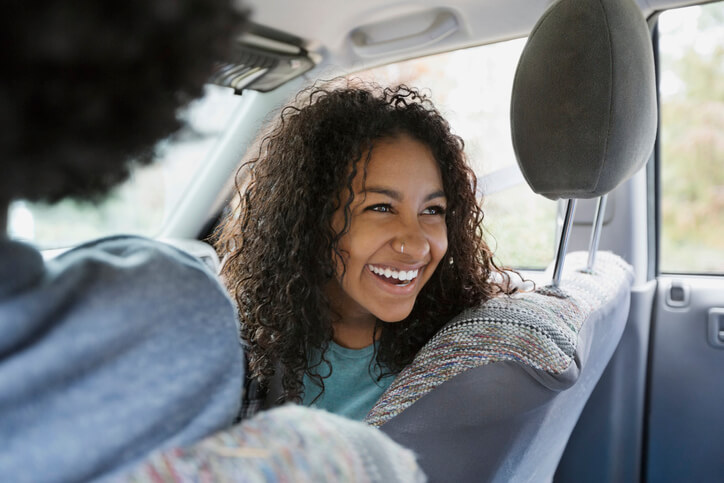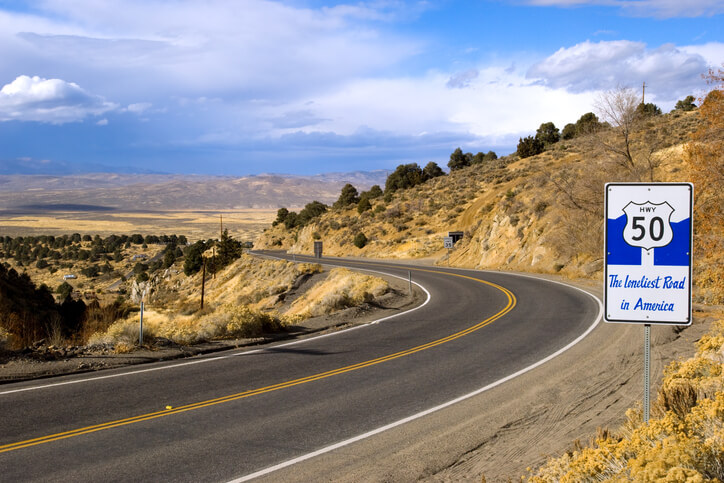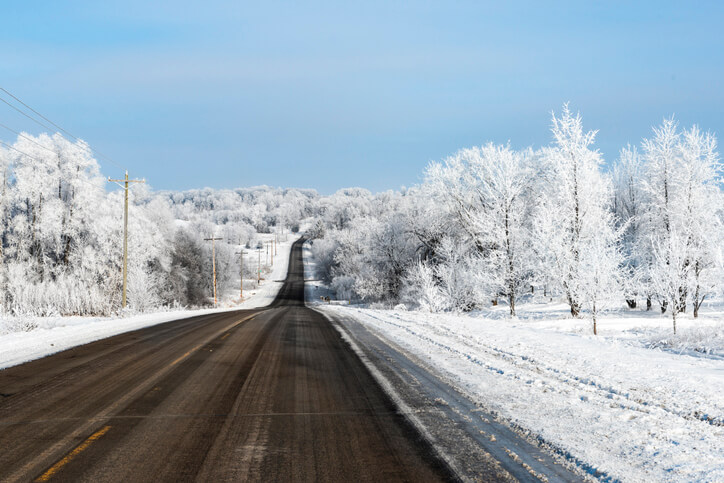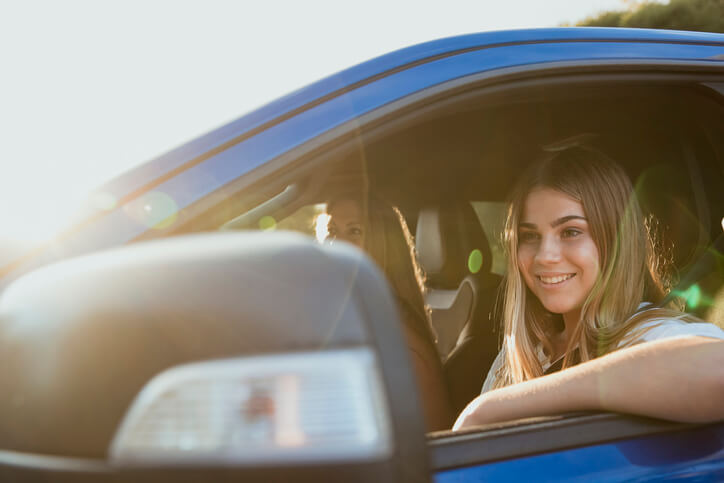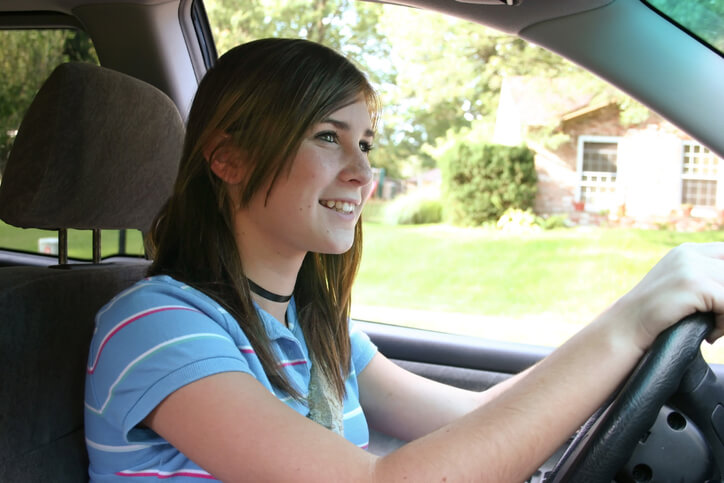Picture this: your teenager just turned 15 and a half, and they’re eager to get behind the wheel. As a parent, you might be nervous about the potential risks associated with teen driving. Understanding California teenage driving laws is essential to ensure your child navigates the road safely and responsibly.
Key Takeaways
- California’s teen driving laws use a graduated licensing system to ensure safety and develop necessary skills.
- Key restrictions for teens include nighttime driving limitations, passenger restrictions, and cell phone usage bans.
- Parents should actively engage in their teen’s education by providing supervised practice, teaching defensive techniques & leading by example.
Understanding California Teen Driving Laws
The primary objective of California’s teen driving laws is to curtail accidents and foster safe driving habits among young drivers using a graduated licensing system. This system recognizes that inexperience contributes to the high likelihood of teen drivers aged 16 to 19 being involved in fatal crashes, three times more than those over 20. California’s graduated licensing system incrementally introduces driving privileges, thus aiding young drivers in acquiring the skills and experience essential for responsible driving.
The graduated licensing system comprises three main stages: obtaining a learner’s permit, a provisional driver’s license, and finally, a full driver license. Throughout this process, teens must adhere to specific requirements and restrictions designed to minimize risks and enhance safety. Parents are pivotal in this journey as they are required to sign the DL 44 Form for applicants under 18, thereby assuming financial accountability for the teen driver.
Moreover, California has zero tolerance for underage drinking and driving, with severe consequences such as license suspension and potential criminal charges for any amount of alcohol detected in a minor’s system while driving.
Learner’s Permit Requirements
For teenagers in California, the first step towards obtaining a driver’s license is getting a learner’s permit. Here are the steps to acquire a learner’s permit:
1. Visit a local DMV office.
2. Fill out the DL 44 Form electronically.
3. Furnish proof of identity.
4. Successfully pass both a vision exam and a written knowledge test on traffic laws and signs.
Teens can acquire a learner’s permit at the age of 15 and a half.
While holding a learner’s permit, teens are required to complete driver training and supervised driving practice before obtaining a provisional license. At this stage, it’s vital to bear in mind that a minor holding a learner’s permit must be in the company of a licensed driver aged 25 or older at all times. This supervised practice ensures that teens gain valuable experience behind the wheel and learn to navigate various driving conditions.
Provisional Driver’s License Rules
After completing the learner’s permit requirements, teens can advance to the next stage: obtaining a provisional driver’s license. At age 16, teens become eligible for a provisional license, provided they have held a provisional instruction permit for at least six months, completed 50 hours of supervised driving (including 10 hours at night), and passed a driving test. While a provisional license grants teenagers the freedom to drive without supervision, it still imposes certain restrictions to safeguard the safety of the driver and others on the road.
For the first 12 months after obtaining a provisional license, teens cannot drive between 11 p.m. and 5 a.m. or transport passengers under 20 years old, unless accompanied by an adult aged 25 or older, a licensed driving instructor, or a parent/guardian. Parents are required to sign the application for a provisional license and are held accountable for any financial obligations associated with the teen driver.
Full Driver’s License Eligibility
Upon maintaining a clean record with a provisional license for 12 months, a teen can upgrade to a full driver’s license at the age of 18. To achieve this, they must fulfill specific criteria, such as accumulating at least 50 hours of driving practice, including 10 hours at night, with a California-licensed driver who is at least 25 years old.
It’s important to note that violating provisional license restrictions or experiencing an accident can result in license suspension, revocation, fines, or other penalties. Therefore, adhering to the restrictions and requirements associated with each stage of the graduated licensing system is essential for ensuring a smooth transition to a full driver’s license.
Key Restrictions for Teen Drivers
Familiarizing oneself with California’s key restrictions for teen drivers is crucial to guarantee compliance and uphold safety on the road. The three primary limitations include nighttime driving limitations, passenger restrictions, and cell phone usage bans. These restrictions are designed to minimize distractions, reduce risks, and help young drivers develop safe driving habits.
During the first 12 months after obtaining a provisional license, nighttime driving is restricted between 11 p.m. and 5 a.m., except for specific exceptions such as medical necessities, school-related activities, or employment-related purposes. Teens with a provisional license cannot transport any passengers under the age of 20 unless they are accompanied. Acceptable companions include adults 25 years old and older, licensed driving instructors and parents or guardians.
Finally, cell phone use while driving is prohibited for teens, with the only exception being in the case of an emergency situation.
Nighttime Driving Limitations
Teen drivers with a provisional license must adhere to the nighttime driving limitations set by California’s teen driving laws. These restrictions prohibit provisional license holders from driving between 11 p.m. and 5 a.m. without a valid reason and adult supervision. The purpose of these limitations is to minimize the risks associated with nighttime driving, as reduced visibility and fatigue may contribute to collisions.
There are, however, certain exceptions to the nighttime driving restrictions for teen drivers. In cases where driving between 11 p.m. and 5 a.m. is necessary, such as medical emergencies, school-related activities, or employment purposes, teens may drive during these hours provided they have a valid reason and are accompanied by a supervising adult aged 25 or over.
Passenger Restrictions
Passenger restrictions are another essential aspect of California’s teen driving laws. For the first 12 months after obtaining a provisional license, teenagers are not permitted to have passengers under the age of 20 in the car. This restriction aims to minimize distractions for inexperienced drivers and reduce the risk of accidents.
However, there are exceptions to this rule. Teen drivers with a provisional license may transport passengers below the age of 20. Accompaniment is compulsory either by an adult aged 25 or above, parent/guardian or a licensed driving instructor. These exceptions ensure that young drivers can still transport family members or participate in carpooling for school or work-related activities when necessary.
Cell Phone Usage
In today’s interconnected world, cell phone usage while driving has become a significant concern, particularly for young drivers who may be more prone to distractions. California law prohibits cell phone use while driving for teens, except in emergencies. This restriction applies to individuals under the age of 18 and aims to minimize the risk of accidents caused by distracted driving.
It’s crucial for parents and guardians to emphasize the importance of avoiding cell phone use while driving. In cases of emergency, such as calling 911, teens are permitted to use their cell phones. Compliance with this restriction aids young drivers in cultivating safe driving habits and maintaining focus on the road ahead.
Penalties for Violating Teen Driving Laws
Non-compliance with California’s teen driving laws can lead to grave consequences for young drivers. Violations may lead to license suspension, fines, and increased insurance rates. For example, drivers under the age of 18 who do not comply with the regulations may experience a 30-day restriction on their license after accumulating two or more points in one year.
Moreover, if they accumulate three or more points in any one year, their license may be suspended for six months and they may be subject to a one-year probation.
It’s essential for teen drivers and their parents to be aware of the potential penalties associated with violating driving laws. By understanding the consequences, young drivers can take responsibility for their actions and prioritize safe driving habits. This, in turn, will help reduce the risk of accidents and ensure the well-being of all road users.
Tips for Teaching Safe Driving Habits
Imparting safe driving habits forms a crucial part of preparing teens for the road. By focusing on supervised practice, defensive driving techniques, and leading by example, parents can help their young drivers develop essential skills and minimize the risk of accidents. These safe driving habits will not only benefit teens during their initial driving stages but also contribute to a lifetime of responsible driving.
In addition to adhering to California’s teen driving laws and restrictions, parents should actively engage in their teen’s driving education. This involvement includes:
- Providing ample supervised driving practice
- Teaching defensive driving techniques to help teens anticipate and avoid potential hazards on the road
- Modeling safe driving behaviors by avoiding distractions and obeying traffic laws.
Supervised Practice
Supervised practice ranks among the most effective methods for teaching safe driving habits. Parents should provide ample supervised driving practice for their teens, ensuring they gain experience in various driving conditions, such as urban streets, highways, and rural roads. This hands-on experience helps young drivers become more comfortable and confident behind the wheel, ultimately preparing them for independent driving.
California requires teens to complete 50 hours of supervised practice in order to obtain a provisional license. 10 of these must be night driving hours. During this time, parents can guide their teens through different driving scenarios, offering feedback and advice to help them develop safe driving habits.
By investing time and effort in supervised practice and driver education, parents play a crucial role in shaping their teen’s driving skills and safety awareness.
Defensive Driving Techniques
Defensive driving techniques are an essential component of teaching safe driving habits. These techniques enable drivers to recognize and avoid potential hazards on the road, thus reducing the risk of motor vehicle accidents. Parents should teach their teens defensive driving techniques such as maintaining a safe following distance, scanning the road ahead for potential hazards, avoiding distractions such as cell phone use, and being cognizant of other drivers’ actions.
By incorporating defensive driving techniques into their driving education, teens can develop the skills necessary to anticipate and respond to potential hazards on the road. This proactive approach to driving safety not only helps reduce the chances of collisions but also promotes a culture of responsible driving among young drivers.
Leading by Example
Parents play a crucial role in instilling safe driving habits in their teens by leading by example. Demonstrating safe driving behaviors, such as refraining from using cell phones while driving, adhering to traffic regulations, and always wearing a seatbelt, sends a clear message to young drivers about the importance of safe driving.
Failing to model safe driving practices may result in children not learning appropriate driving behaviors, which could lead to an increased likelihood of engaging in dangerous activities while driving. By setting a positive example and prioritizing safe driving habits, parents can help their teens develop the skills and behaviors necessary for a lifetime of responsible driving.
Navigating Insurance for Teen Drivers
Due to their classification as high-risk drivers, resulting from their lack of experience and a higher likelihood of being involved in accidents, insurance for teen drivers can be costly. However, finding affordable coverage is possible with a bit of research and effort. Shopping around and comparing quotes from different insurance providers can help parents find the best coverage for their teen drivers at a reasonable price.
Some tips for finding cost-effective coverage include:
- Taking advantage of discounts, such as those for good students, multi-car policies, and safe drivers
- Considering increasing the deductible and reducing coverage to lower insurance premiums
- Thoroughly researching and comparing insurance options
By following these tips, families can find the best coverage for their teen drivers without breaking the bank.
Graduated Driver's License Program in California
The Graduated Driver’s License Program in California offers a structured pathway for teens to earn the privilege of operating a motor vehicle on the state’s roadways, ultimately leading to obtaining a class c driver’s license. This program consists of:
- Obtaining a driver’s permit
- Accruing 50 hours of driving
- Obtaining a restricted license
- Adhering to restrictions on driving times and passengers
The intent of the Graduated Driver’s License Program is to gradually increase driving experience prior to obtaining a full driver’s license.
Adherence to the stages and restrictions of California’s Graduated Driver’s License Program allows teens to cultivate the skills and experience required to become responsible motorists. This gradual approach to driving privileges helps ensure that young drivers are adequately prepared for the challenges and responsibilities associated with operating a motor vehicle on California’s roadways.
New Residents and Out-of-State Licenses
New residents possessing a valid out-of-state license are required to apply for a California driver’s license within ten days upon establishing residency. The process for obtaining a California driver’s license includes:
- Visiting a local DMV office
- Providing proof of identity and residency
- Passing a vision exam
- Passing a written knowledge test on traffic laws and signs
If the out-of-state license has expired, a driving test may also be necessary.
Applying for a California driver’s license as a new resident may seem daunting, but the process is relatively straightforward. By following the necessary steps and preparing for the required tests, new residents can successfully obtain a California driver’s license and enjoy the freedom and responsibility of driving in the Golden State.
Foreign License Holders
Foreign license holders aspiring to secure a California driver’s license must adhere to a procedure akin to applying for a new license. This includes:
- Visiting a local California DMV office
- Providing proof of identity
- Passing a vision exam
- Passing a written knowledge test
- Passing a driving test
Foreign license holders should be prepared to familiarize themselves with California’s traffic laws and regulations to ensure a smooth transition to driving in the state. By understanding the requirements and process for obtaining a California driver’s license, foreign license holders can confidently navigate the roadways and enjoy the freedom of driving in California.
With the proper preparation and adherence to the state’s traffic laws, foreign license holders can experience the excitement and responsibility of driving motor vehicles in the diverse and beautiful landscapes of California.
In Conclusion
In conclusion, understanding and adhering to California’s teen driving laws is essential for the safety and well-being of young drivers and all road users. By following the graduated licensing system, engaging in supervised practice, learning defensive driving techniques, and leading by example, parents can help their teens develop safe driving habits that will last a lifetime. With diligence and cooperation, we can work together to create a safer driving environment for everyone on California’s roadways.
Frequently Asked Questions
What are the rules of for a 16 year-old driver in California?
At 16 years old, a teenager in California is able to apply for a provisional driver’s license as long as they have held a learner’s permit for at least six months, completed 50 hours of supervised driving, and pass a driving test. While permitted, the teen driver must be accompanied by a licensed adult driver who is at least 25 years old. During the first 12 months after licensure, a minor cannot drive between 11 p.m. and 5 a.m., or transport passengers under 20 years old unless accompanied by a California-licensed parent or guardian, a California-licensed driver 25 years old or older, or a licensed or certified driving instructor.
Can a 17-year0ld driver have passengers in California?
At 17 years old, a driver in California is not allowed to have passengers under 20 years of age unless they are accompanied by a licensed driver 25 years or older, or a parent/guardian. For the first 12 months after obtaining a provisional license, the driver must also be accompanied by an adult between 11 pm and 5 am.
What do I need to get a driver’s license in California?
To get a driver’s license in California, you need to head down to the DMV with a completed original Form DL 44, proof of identity, two proofs of residency, proof of your current name, and a certificate of completion of driver’s education, as well as $35 for fees. A parent/guardian must also be present to sign paperwork.
At what age can teenagers in California obtain a learner’s permit?
Teenagers in California can obtain a learner’s permit at age 15 1/2 by visiting a DMV office and fulfilling the necessary requirements.
What are the nighttime driving limitations for teen drivers with a provisional license?
Teen drivers with a provisional license are restricted from driving between 11:00 PM and 5:00 AM, as mandated by most common advice.

